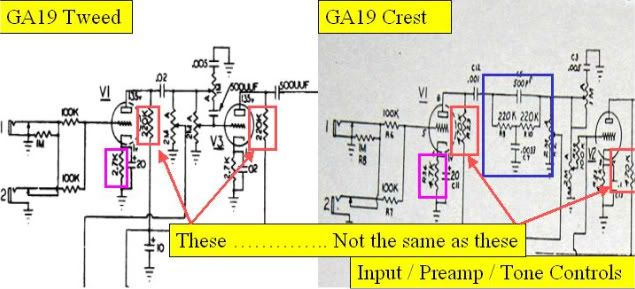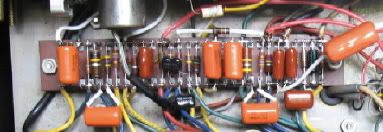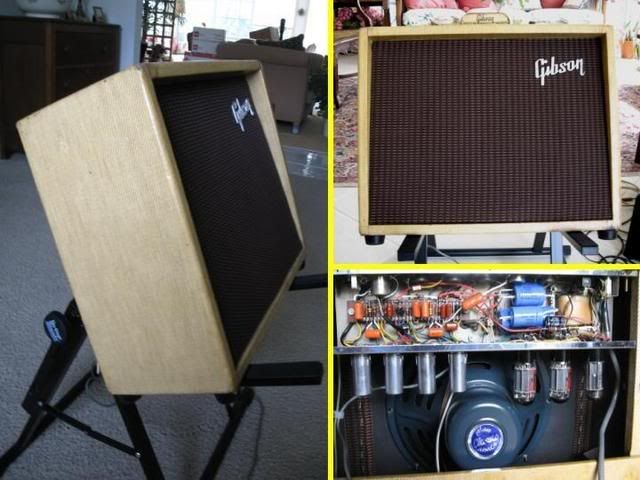This is, in part, to fix a boo-boo in the other GA19RVT thread and a closer look at these two versions of the same model. One of our BBers owns a 'Crest' version and I have a standing offer to do general maintenance on his. He also said that his didn't break up as early as a Tweed. I recently offered to 'degrade' his 6V6/5Y3 model back to a Tweed so, in case he takes me up, I guess knowing what the differences are would be helpful .... If you're singing along at home; schematics Tweed and Crest. What they look like; the Tweed version takes its name from the patterned, cotton twill-backed, 'table-cloth'-style vinyl tolex and the Crest version from the dookie little coat of arms 'crest' on the chassis (the red spot):

The orange/brown stains commonly seen on the Tweeds is a mold caused by the water-based tolex glue and the cotton tolex-backing; easily 60% of the remaining tweed amps have the stains in varying degrees. Roughly, the tweed version was in production '60-'62 and the Crest '63-'65. I don't believe the model was re-done in Gibson's 'white face/doghouse' cosmetics but was done over later in black tolex, stick-em-on faux wood-grain paper on the control panel (for more transparent highs :wink: ) and with the cab sides sticking above the top so that there would be something to break off if the cabinet were dropped or tipped over. For more on Gibson amps, see Mr. Marx' fine book Gibson Amplifiers, 1933-2008.
Preamp: The cathode resistors (magenta box) are different although the value of the bypass cap is the same (also applies to the other tube section shown below). This resistor sets the bias of the tube section. The Crest model has the larger value resistor inducing a larger voltage on the cathode giving, all things being equal, a somewhat hotter tone. The volume/tone controls (green box) are too similar to be worth messing with. The coupling caps (red circle) indicate a larger value in the same position for the Tweed model. Finally, the blue box is a filter in the Crest model not found in the Tweed version. To Tweedify this section, the cathode resistors would be matched, the coupling cap upsized, and that Crest filter would be disconnected at one end and jumped out of the circuit.
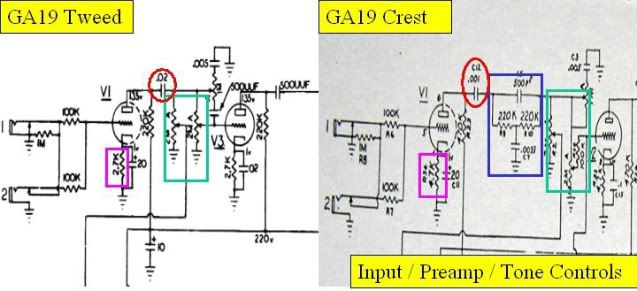
Phase Inverter / Output: The magenta boxes show the voltage divider; the source of the AC signal when it swings to the common side; design is the same, only the resistor values are different. The Crest model has a small value cap (blue box) from one plate supply leg to the other. Not really certain what it does but maybe acts to filter out high frequency oscillation or maybe absorb cosmic rays ... who knows. To Tweediate the Crest model, those voltage divider resistors would be matched to the tweed values and that cap discarded.

Reverb: Except for the 7199 reverb operator in the Tweed and the 6C4 in the Crest, these are identical. The 7199, sometimes used in Ampegs and always used in the workhorse Dynaco ST70 35 wpc stereo amp, is a split design - two different tubes in the same bottle. One side is a typical triode; plate/grid/cathode ... like one half of a 12A_7, but the other side is a pentode ... more in common with a power output tube than a preamp tube. The blue box shows the more elaborate 7199 circuit in the Tweed model but, with a twin-triode 6C4, no need for that stuff there. Finally, the footswitch got moved; in the Tweed it's across the output of the reverb can; in the Crest, it's in the reverb return leg. Tweedification? Nothing to do.

Tremolo: Gibson tremolo, with fresh parts, is organic and pleasing and Gibson had the (rare) good sense to stick with something that worked well. The modern ear seems to like slower 'Speed'; can be done by replacing some of the caps and resistors ... but will leave that for another day. The Crest model has an additional 100K resistor (not highlighted; just right of C2) whose function I don't understand; since it's otherwise the same as the Tweed ... nothing to do here.
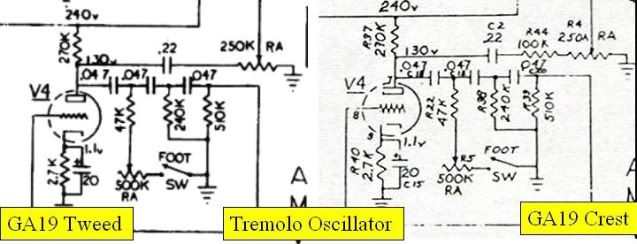
Power Supply:
Dropping resistors: 470/1W, 4.7K/1W, 10K/.5W: same for both models
Filter capacitors: Tweed: 20uf/10uf/10uf ... Crest: 20uf/20uf/10uf
The difference in filter caps is the section for the 6V6 screens; the screen supply is commonly regulated in higher power/better grade amps like the Guild Quantum and others; the increased uf in the Crest model might provide a slightly tighter sound. I'd be more inclined to bump the Tweed up than change out an otherwise good cap in a Crest.
There you have it and assuming the same output transformers - to degrade a Crest back to a Tweed; change out the preamp cathode and voltage divider resistors, bump up a coupling cap, jump out that Crest filter and ... when your hairs comb right and your pants are tight it's gonna be all right. John

The orange/brown stains commonly seen on the Tweeds is a mold caused by the water-based tolex glue and the cotton tolex-backing; easily 60% of the remaining tweed amps have the stains in varying degrees. Roughly, the tweed version was in production '60-'62 and the Crest '63-'65. I don't believe the model was re-done in Gibson's 'white face/doghouse' cosmetics but was done over later in black tolex, stick-em-on faux wood-grain paper on the control panel (for more transparent highs :wink: ) and with the cab sides sticking above the top so that there would be something to break off if the cabinet were dropped or tipped over. For more on Gibson amps, see Mr. Marx' fine book Gibson Amplifiers, 1933-2008.
Preamp: The cathode resistors (magenta box) are different although the value of the bypass cap is the same (also applies to the other tube section shown below). This resistor sets the bias of the tube section. The Crest model has the larger value resistor inducing a larger voltage on the cathode giving, all things being equal, a somewhat hotter tone. The volume/tone controls (green box) are too similar to be worth messing with. The coupling caps (red circle) indicate a larger value in the same position for the Tweed model. Finally, the blue box is a filter in the Crest model not found in the Tweed version. To Tweedify this section, the cathode resistors would be matched, the coupling cap upsized, and that Crest filter would be disconnected at one end and jumped out of the circuit.

Phase Inverter / Output: The magenta boxes show the voltage divider; the source of the AC signal when it swings to the common side; design is the same, only the resistor values are different. The Crest model has a small value cap (blue box) from one plate supply leg to the other. Not really certain what it does but maybe acts to filter out high frequency oscillation or maybe absorb cosmic rays ... who knows. To Tweediate the Crest model, those voltage divider resistors would be matched to the tweed values and that cap discarded.

Reverb: Except for the 7199 reverb operator in the Tweed and the 6C4 in the Crest, these are identical. The 7199, sometimes used in Ampegs and always used in the workhorse Dynaco ST70 35 wpc stereo amp, is a split design - two different tubes in the same bottle. One side is a typical triode; plate/grid/cathode ... like one half of a 12A_7, but the other side is a pentode ... more in common with a power output tube than a preamp tube. The blue box shows the more elaborate 7199 circuit in the Tweed model but, with a twin-triode 6C4, no need for that stuff there. Finally, the footswitch got moved; in the Tweed it's across the output of the reverb can; in the Crest, it's in the reverb return leg. Tweedification? Nothing to do.

Tremolo: Gibson tremolo, with fresh parts, is organic and pleasing and Gibson had the (rare) good sense to stick with something that worked well. The modern ear seems to like slower 'Speed'; can be done by replacing some of the caps and resistors ... but will leave that for another day. The Crest model has an additional 100K resistor (not highlighted; just right of C2) whose function I don't understand; since it's otherwise the same as the Tweed ... nothing to do here.

Power Supply:
Dropping resistors: 470/1W, 4.7K/1W, 10K/.5W: same for both models
Filter capacitors: Tweed: 20uf/10uf/10uf ... Crest: 20uf/20uf/10uf
The difference in filter caps is the section for the 6V6 screens; the screen supply is commonly regulated in higher power/better grade amps like the Guild Quantum and others; the increased uf in the Crest model might provide a slightly tighter sound. I'd be more inclined to bump the Tweed up than change out an otherwise good cap in a Crest.
There you have it and assuming the same output transformers - to degrade a Crest back to a Tweed; change out the preamp cathode and voltage divider resistors, bump up a coupling cap, jump out that Crest filter and ... when your hairs comb right and your pants are tight it's gonna be all right. John
